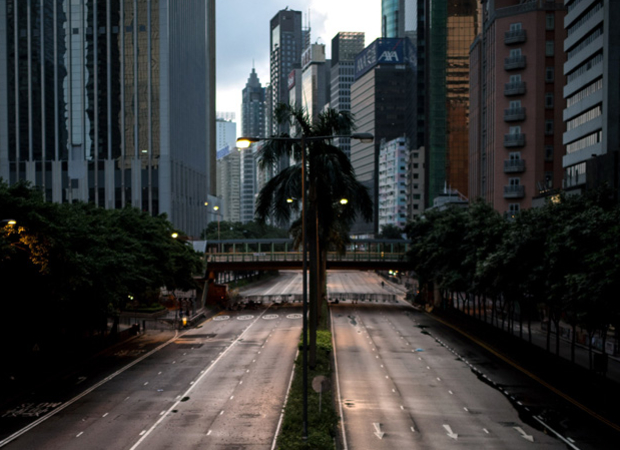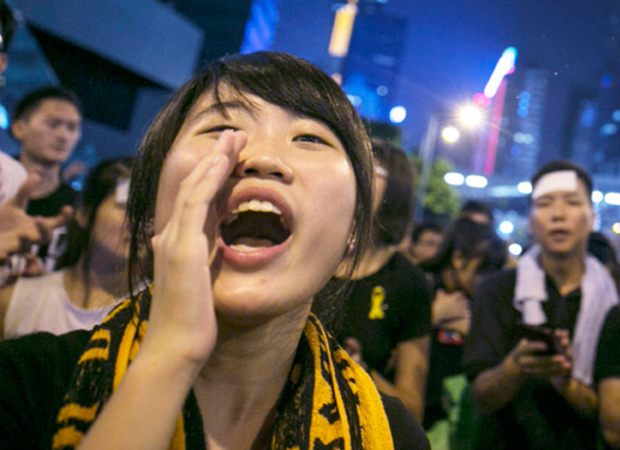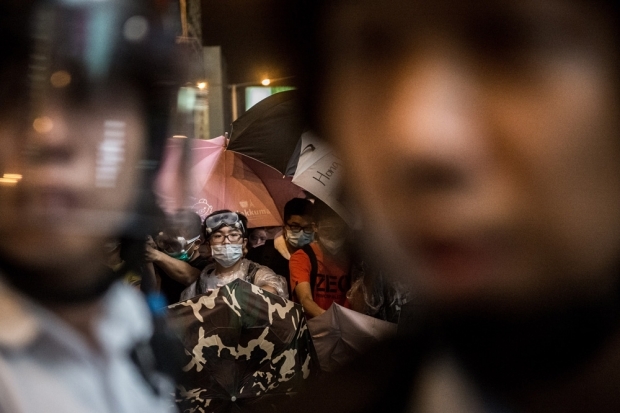Snip. Snip. Snip. The officer’s face shows concentration as he cuts one yellow ribbon after another along a metal fence on Queensway in the Central district of Hong Kong. Next to him, other policemen have just finished dismantling the barricades that had blocked this major artery for more than two weeks and they are now busy disposing of the bamboo poles, security barriers, chairs, plastic cling film, umbrellas, and wooden boards that protesters had piled up in the street to block cars.
The officer, in his blue overalls, takes pains not to overlook even the smallest remnant. Snip. Snip. He cuts away the last resisting strand of acrylic yellow ribbon. He looks frustrated. These ribbons are the symbol of the Occupy Movement—and of its quest for universal suffrage in Hong Kong—and they are everywhere. You see them wrapped around tree branches in Tamar Garden, at the entrance to the Government Headquarters building, pinned on people’s lapels or on their rucksacks and handbags as you walk past them on the subway or in the street. You find them wrapped around fences and lampposts throughout the city and on university campuses. Walking near the escalator that leads to the IFC shopping mall, I saw two young women, speaking Mandarin, perhaps tourists from the mainland, pointing to a ribbon tied to an ornamental plant. Even online, people have substituted their profile photos on Twitter and Facebook with a yellow ribbon on black background. But the officer in blue overalls looks at them as one would a personal foe and cuts them off.
Viewpoint
10.01.14
‘The City Feels New’
Since Monday October 13, the police presence around Admiralty, the main protest-area in Hong Kong, had become stronger and more assertive, and tensions had been rising around the margins of the occupied areas. In an effort to restore traffic, police had dismantled unmanned barricades put up by the protesters to act as a “buffer zone.” Benny Tai, a Law professor at Hong Kong University and one of the three founders and leaders of the group Occupy Central with Love and Peace, told me: “We have long said to the protesters that we should minimize the impact of our action, and let go of the barricades that are too far away or do not have many people around them, in order to concentrate our efforts here, in Admiralty. But it does not work this way: people get very attached to their own barricade. They tell me ‘I cannot let it go, this barricade is my home.’ And we are not able to convince them otherwise.” He smiled a tired smile, as we talked not far from the tent where he had spent the night, adding: “Of course, this is a leaderless movement. There are many different views among those who are participating. It is the beauty and strangeness of it.”
On a Sunday morning, a group of runners which has organized an “Umbrella Marathon” is just returning to Admiralty, flushed and sweaty, dressed in black and yellow and sporting stickers that proclaimed “Support the Students!” decorated with yellow ribbons and umbrellas.
During the weekends the protest sites—in Admiralty, Causeway Bay, and Mongkok— filled with people who strolled around and stopped to read posters and take photos of the unexpected art on the streets. A revelation to many, in a city where creativity has a hard time finding places to develop, the Umbrella Art has been galvanizing galleries and curators alike—and efforts are being made to preserve it.
Viewpoint
10.08.14
‘We Do Not Want to Be Persuaded’
Weekdays, fewer people came around. They were at work or in class. Still, office workers came to have lunch on the large traffic-free roads, and after sunset more people returned to listen to the speeches and to attend classes in the “Mobile Democracy Classrooms” manned by educators, social workers, members of the pro-democracy political parties, and protest participants.
The weakest moment, for the protesters, was always in the first hours of the morning, right after dawn. This was the time the police chose each day to clear out barricades and cut ribbons.
On October 13, the battle for Queensway’s barricades lasted all day. Police cleared them out and immediately the protesters came back and reinforced the remaining ones right under the police’s sullen gaze. Meanwhile, a few angry taxi and truck drivers shouted at the students to go home and open the streets.
But that very night a group of construction workers, cheered by the crowd, arrived with long bamboo poles to teach the protesters how to erect the lattice scaffoldings that are a trademark of Hong Kong’s building sites. The structures stood majestic for just a few hours: at dawn the police came back with electric saws, and they melted away.
The loss of the barricades before any concession by the government seemed to exasperate the protesters and the confrontation grew more intense through the day, peaking that night. Rodney Street, a small side road leading onto Queensway, was occupied by protesters staging a sit-in opposite a row of policemen on their feet. Then some decided to try and block Lung Wo Road, one of Hong Kong’s newest streets, newly risen from the seas in one of the biggest, most scarring and protested reclamation projects in recent memory. Lung Wo Road was a contentious place even before it existed, and it became a theater for some of the most violent episodes of this autumnal Hong Kong Spring.
Park and Sam, two young men dressed in black with goggles and gas masks dangling from their necks, were sitting on top of the concrete partition of Connaught Road, in a state of great excitement. “We are both IT workers for a local magazine,” said Park. Sam strained his neck to see what a commotion happening a little ways off was about. He shouted that the police had come, and they both flew away, taking their umbrellas as protection against pepper spray and tear gas. I sat on the concrete partition, waiting for them to come back, which they did long enough to tell me that they were both 22. “I have been here since September 26,” Sam said. Park had only spent one week in the streets. As we started to talk more, somebody shouted that the police were approaching from the other side, and the young men were gone again.
Near the main podium, right underneath the two bridges that take pedestrians into the Admiralty Centre (a busy shopping mall and office building), where speakers have been passing the microphone to each other for discussions with the crowds, I saw Father Mella. An Italian priest who has been in Hong Kong since 1974, and has fought in every major rights battle Hong Kong has seen, since the protests began he had been making the rounds between Mongkok, Causeway Bay, and Admiralty. “Be careful,” he said, “there are all sorts of people around tonight. It could get dangerous,” making a wide gesture with his hands that meant there was little anybody could do about it.
Closer to Lung Wo Road, Lillian, a 21-year-old wedding photographer, and her friend Becky, 20, who studies translation at Hong Kong University, had just arrived from Mongkok to “defend the barricades here,” as Becky put it. “It is a very different atmosphere up in Mongkok, more grassroots, more interesting, there is a lot of interaction with different classes of people that normally do not speak to each other. But tonight we need to come here; the police [are] dismantling the barricades at this site, and we need to be present,” she said. Dressed in black and wearing combat boots, with the trademark tools of the protesters—the goggles, the mask, the umbrella, the yellow ribbon—she still had the manners that have impressed observers. “You should not be wearing sandals tonight! Can you run in those?” she scolded me. “What if the police charge? You might hurt your feet,” echoed Lillian. When I asked why they were there, and whether occupying Lung Wo Road was really so important, Lillian looked desperate: “It is our only bargaining chip. So we are in Admiralty and not in Mongkok tonight because we need to support the people here, help them keep the roads. When the danger here is over, we will get back,” she said. Becky nodded: “The road. It is only by keeping the road that we can bargain. They do not want to hear us and we know we cannot trust our government. We cannot trust China. We cannot trust the police. We can only trust each other and keep the road.”
They would do so through the night. Then Becky had to go to class in the morning, and Lillian had a wedding photo shoot scheduled. They both laughed at the contrast.
The day after, though, nobody laughed in Hong Kong. On Wednesday October 15, the city woke up to the brutal images of police dragging away a handcuffed man and beating him viciously in a dark corner—as filmed by TVB, a TV station that had been lambasted for weeks by the protesters for its pro-government stance. The original video, with partial translation [warning: graphic images] has been edited by TVB, deleting some of the most disturbing scenes.) The man, it was soon revealed, was Ken Tsang Kin-Chiu, a social worker and member of the Civic Party, a constant presence at political demonstrations. The images of his bruised body sealed, for many, the end of trust in the police. That same evening a large demonstration took place in front of the Police Headquarters on Arsenal Street. Hundreds of protesters shouted at the policemen who gazed fixedly ahead trying to ignore photo stills of the beating and pictures the protesters were holding of Tsang’s bruises. Among them, also holding up the pictures of the badly bruised Tsang, were half a dozen people in wheelchairs angry to see an advocate for the disabled treated so badly. Jane, a 43-year-old social worker, stood watching with her arms wrapped around her waist and tearful eyes. “I am very sad for my city,” she said. “I could not even watch the whole video. I have never been at a demonstration before. What will happen to Hong Kong now?” Her voice broke, and before she excused herself she wondered: “How can the Hong Kong police do this to the Hong Kong people?”
Hong Kong is a city of many levels. Bridges, footpaths, and elevated walkways connect buildings and cross roads, creating hanging spaces and vantage points. All around the Police Headquarters the bridges were full of people taking photos with their phones, letting one another gain the best spot along the yellow-ribboned fence to photograph the demonstration in a stunned silence. At Admiralty, meanwhile, the crowds grew as the battle for Lung Wo Road restarted. Fight, occupy part of the street, get pushed back by the police. Until in the afternoon a press conference was urgently called, and Leung Chun-ying, the Chief Executive, Carrie Lam, the Chief Secretary, and Raymond Tam, the Secretary of Constitutional and Mainland Affairs, told journalists that a dialogue could be had, but that no major changes could be made to the National People’s Congress deliberation on universal suffrage for 2017.
On Friday October 17, again at the crack of dawn, police dismantled the barricades at Mongkok and cleared the site, cutting away every yellow ribbon. That night, another battle, another standoff, and Mongkok was re-occupied, snatched from the police. The stalemate continues, but by now it has left deep open wounds in the city: a police force that is no longer trusted, a younger generation increasingly full of anger and suspicion that measures its success by the square inches it can occupy, and a fiddling government, incapable of dialogue, that has to wait for the stillness of dawn to reclaim the streets.




